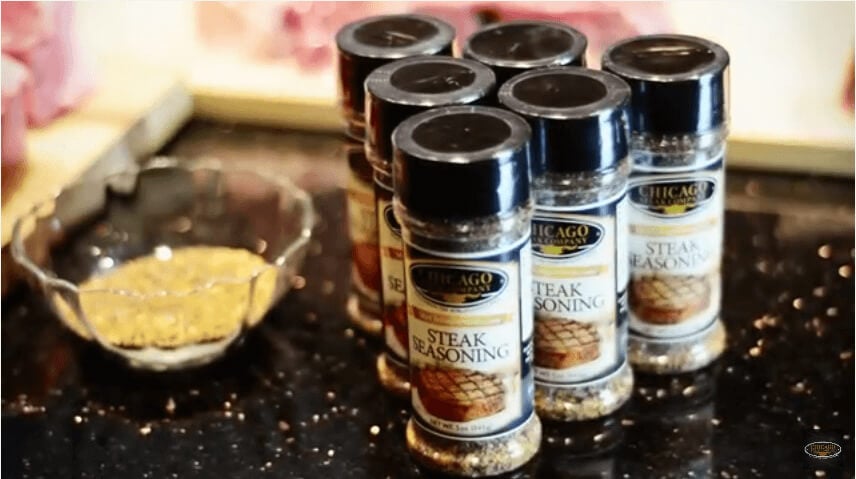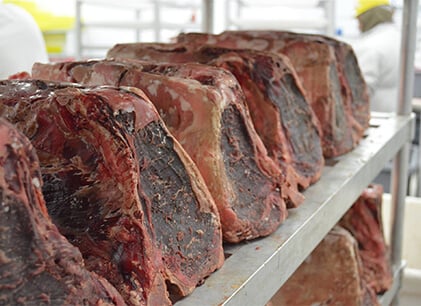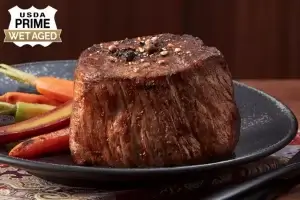
The Art & Science of Preparing Steaks (Part I)
Great steaks start with great seasoning and flavoring techniques. Whether you prefer a simple, pre-grill salting, a homemade marinade, or a thorough dry rub, your steak’s flavor rests (as always) on great ingredients and great technique.
In this two-part series, Steak University breaks down the six most common ways you can improve the flavor and texture of your steak before cooking.
In Part I, we cover three methods any beef lover worth his or her salt should have down pat: salting, dry brining, and wet brining.
Salting 101
What Salting Is: Salting is the simplest, most common form of seasoning used to flavor steaks. Using table, kosher, sea or seasoned salt, chefs sprinkle a thin layer over steaks immediately before cooking.
What Salting Does
Plain and simple, salting provides extra flavor. Also, though not technically a flavor enhancer, salt brings out certain other flavors by suppressing others. Unlike dry or wet brining, adding salt to a steak right before grilling, broiling, or frying doesn’t provide enough time for major chemical or structural changes to occur to your steak.
How To Salt Your Steak
If you are only salting for surface flavor (as opposed to dry brining), it is best to salt immediately before cooking. Some pan-fry steak chefs will even go so far as to salt the pan instead of the steak. This is because salt extracts moisture, so the longer you let salt sit on your steak, the more juiciness you lose.
How Salting Works
Salting will extract some level of juices from your steak, but so long as salting is done right before cooking, this moisture loss will be minimal. Salt’s biggest contribution when used this way is its flavor. Human taste buds crave sodium, and while a salt-overdose can ruin the flavor of any meal, well-salted steaks are renowned for their flavor and simplicity. Even better salt suppresses bitter tastes. This makes sweet and savory flavors easier to detect.
When To Salt A Steak
Unless you’ve already brined, rubbed, marinated, or injected your steak with something salty, salting can be used to bring flavor to almost any steak cooked under dry, extreme heat. However, some cuts of beef – such as briskets or fore shanks – require cooking methods that do not lend themselves to traditional salting.
Dry Brining 101
 What Dry Brining Is
What Dry Brining Is
The first step of dry brining is identical to salting: the cook spreads a thin layer of salt over both sides of a steak. The difference lies in time. Dry brined steaks are left to sit for 45 minutes to 48 hours before being cooked.
What Dry Brining Does
Dry brining has two main advantages. First, salt flavors go deeper into your steak. Second, your steak’s meat becomes more tender.
How To Dry Brine Your Steak
Dry brine your steak by seasoning it generously with salt and refrigerating it uncovered for at least one hour, up to a maximum of 3 days. This process enhances the steak’s flavor and tenderness, with 24 hours being an ideal brining time for optimal results.
Cook a dry brined steak too soon, and you’ll lose precious juices.
How Dry Brining Works
The flavor added by dry brining is the same as with regular salting. The difference is how deeply that flavor reaches, and the added tenderness dry brining gives your steak.
Dry brine works by extracting moisture from the steak (you’ll see droplets appear on the surface ten to twenty minutes in). When this happens, the salt begins to dissolve. The dissolved salt then begins to melt back into the meat. This causes a chemical reaction between the dissolved salt and the steak’s protein tissues. Muscle fibers loosen and tenderize, which allows the salt to seep more deeply into the steak.
The result is a tenderer steak, with added flavor throughout, instead of just on the surface.
When To Dry Brine A Steak
Dry brining, like salting, is an excellent choice for any cut of steak that is cooked using extreme, dry heat. It is particularly useful for slightly tougher cuts, like flank steak or hanger steaks, allowing these cuts to tenderize somewhat before cooking.
Wet Brining 101
 What Wet Brining Is: Wet brining – sometimes confused with marinating – is a simple, straightforward equation: Salt + Water + Meat. Sugar optional.
What Wet Brining Is: Wet brining – sometimes confused with marinating – is a simple, straightforward equation: Salt + Water + Meat. Sugar optional.
What Wet Brining Does
Wet brining has many of the same advantages as dry brining. It permeates a steak with salt flavor and helps tenderize muscle tissue. Sugar-added brines receive the flavor benefits of sugar (which is a natural flavor enhancer), and brown more easily. Unfortunately, wet brining for moderate to long periods can have the effect of drawing meat juices out of your steak.
How To Wet Brine Your Steak
To make a flavorful brine for steak, combine 2 ½ cups of water, ⅓ cup bourbon, ⅓ cup honey, 3 tablespoons kosher salt, lemon zest, and black pepper in a bowl. Stir until the salt dissolves, then add garlic. Marinate steaks in the brine for 6-8 hours, ensuring they are well-coated, before grilling or cooking to your desired doneness.
How Wet Brining Works
Wet brining flavors meat the same way dry brining does. Because the saline (saltwater) solution is pre-dissolved, wet brines begin to tenderize and permeate meats faster than dry brines. This makes the minimum time for wet brining shorter than dry brining. Wet brines also have the advantage of making meat plumper and moister, as the brine gets absorbed by the tenderized tissue.
Sugars in brines take much longer to get absorbed, and are usually found near the surface of meats. Sugar’s chemical makeup has two advantages in brine beyond its own flavor. First, sugar naturally makes other flavors taste stronger to human taste buds. Second, sugar speeds up the chemical process known as the Maillard reaction – what gives your steak its crisp, delicious brown crust.
When To Wet Brine A Steak
Wet brining is more common for chicken and pork chops than steaks – especially higher-end cuts. A major reason for this is that juices often bleed out and mix in with the rest of the brine. As a result, any flavor gained by adding brine is often a trade-off for lost steak juices. That said, for cheaper, tougher cuts of beef, wet brining can be a smart option.
Part II: Bolder Flavors
Want to learn more ways to make your steaks taste even better? Curious about the workings and bolder flavors of rubs, marinades, and – yes – home injection?
Then join us for Part II.
Browse our selection of USDA Prime Wet Aged and Dry Aged steaks and let us know which salting method you prefer.



